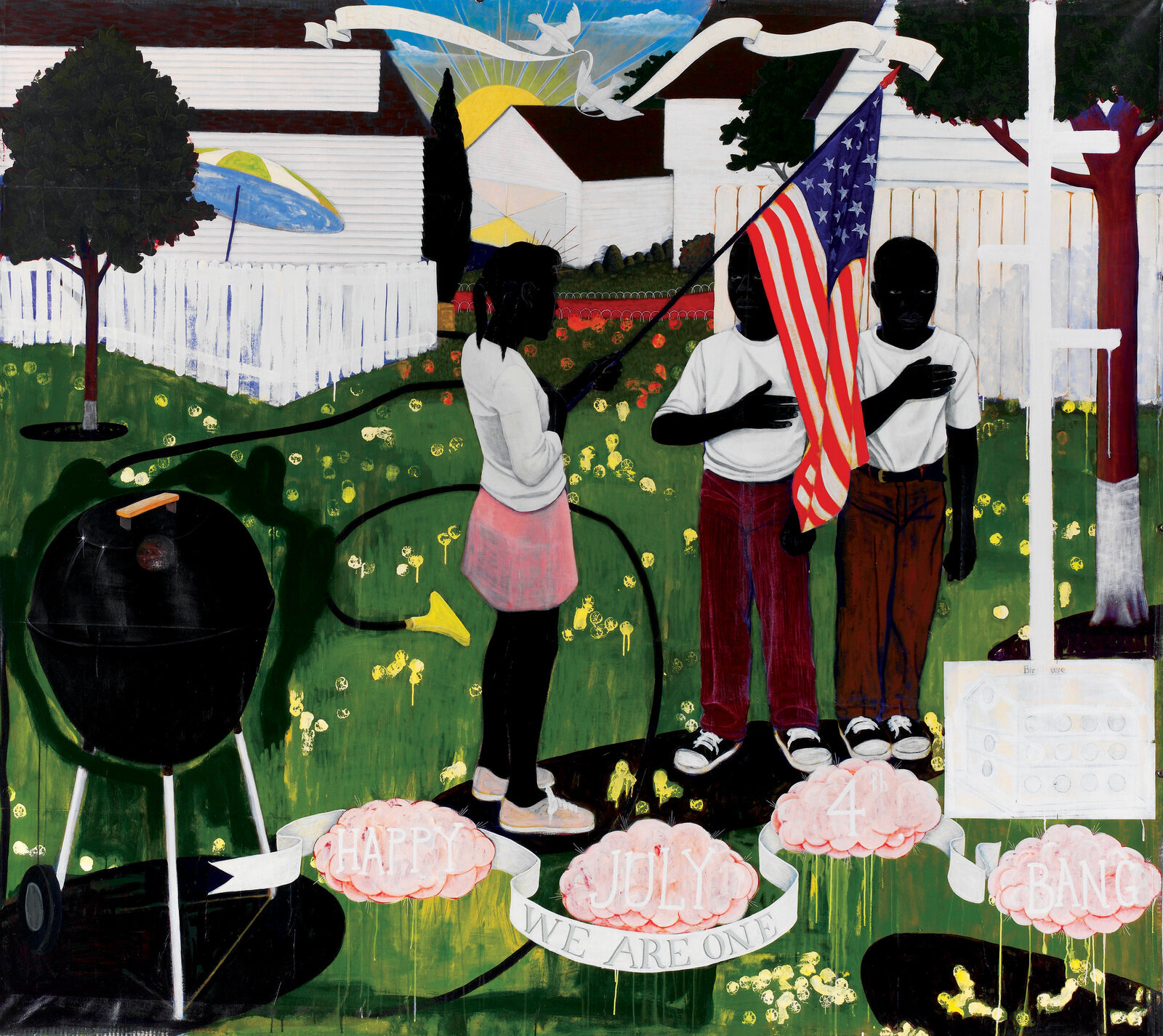
The late exhibition Liminality in Infinite Space held at the African Artists’ Foundation in Lagos has revealed much of contemporary African art’s appeal for figuration and portraiture – catalogue accessible here. The show’s intention seems to be twofold. First, “this exhibition arches back to more traditional art-making practices including painting, collage, tapestry and woodcuts”. Secondly, and from a representation standpoint, “it intentionally moves away from exaggerated depictions of blackness towards sharing moments of vulnerability and unostentatious joy”. It is no surprise at a time in which the black body is subjected to all sorts of gaze, subjugation, aggression or praise.
In an era in which the black body is still instrumentalised or the subject of all kinds of fantasies, Liminality in Infinite Space unveils the black body in its sovereign intimacy.
Zandile Tshabala. Paradise IIIIII. 2020. Acrylic on Canvas. 120 x 90 cm. © Zandile Tshabala /AAF – retrieved
Scrolling through the social media feeds relating to contemporary African art at the moment, it is as if Kerry James Marshall’s influence has been revived. The black figures portrayed in the works of Johnson Eziefula, Zandile Tshabalala or WonderBuhle are of a striking dark tone. This figurative tendency – that could be perceived as a statement – rather bears humble intentions. This collective exhibition has black people’s ordinary and everyday life as visual mandate and inspiration.

© Kerry James Marshall 'Bang' (1994), Acrylic and collage on canvas, 104 x 120 in.
Prior to that exhibition, the curator, Azu Nwagbogu – director of the African Artists’ Foundation – put up a group show entitled The Medium is the Message at the gallery Unit London. The two exhibitions actually share the same agenda. Nwagbogu’s curatorial effort seeks to let the black identity being first and foremost an elementary matter, solely expressed by the medium. The variety and richness of visual and artistic expressions in both shows are truly accounting for the sensitive and honest nature of black identities. Such figurative works remind us that contemporary African portraiture can remain safe, non-defining and unostentatious in relation to the black body.

Installation shot of exhibition 'The Medium Is The Message' Curated By Azu Nwagbogu
Figurative painting and portraiture require a certain degree of technique and control that is, in this context, at the service of vulnerability, of the natural. The Nigerian art scene has seen powerful hyperrealist realisations taking the headlines. Such artistic achievements are often appreciated in regard to their high technical requirements. In losing on the strict exactitude of the traits or the resemblance, and giving their personae a strong shared visual composition, contemporary artists such as Kwesi Botchway or Amoako Boafo let the black body and identity express itself with indeterminism and conviction.
Kwesi Botchway. Like Son Like Father. 2020. Acrylic on Canvas. Approx. 150 x 140 cm. © Kwesi Botchway - retrived
The exhibited artists and many of their contemporary peers seem to navigate between realist depictions or portraits, and unsettling projections. Inspired by the everyday life and the mundane, their portraits leave room for self-appropriation. Looking at Raphael Adjetey Adjei Mayne’s body of work, we ultimately sense the global and afro-individual appeal of his anonymous gesture, that is here performed to its utmost. The ability to remain anonymous is a privilege black people have enjoyed too little. Currently having a solo exhibition entitled ‘The Joy of My Skin’ at the contemporary art gallery Geukens & De Vil in Antwerp (Belgium), Mayne states that: “In a world that focuses on pain and images of brutality and battered bodies, creating joy is truly a radical act”. His statement echoes the late exhibition Liminality in Infinite Space’s intention.
Raphael Adjetey Adjei Mayne. In Hands. 2020. Acrylic on Canvas. 205 x 160 cm. © Raphael Adjetey Adjei Mayne – retrieved
This soft and mundane figurative gesture towards blackness in contemporary African art is refreshing in a mass-media visual culture that swallows the black body in fetishization and hyper-stylization. In many cases, the vulnerable yet determined gaze of the characters portrayed seizes the viewer with empathy. The different uses or approaches to the medium are here supporting the expression of the plurality of black identities.
Amy Sherald. Precious Jewels by the Sea. 2019. Oil on Canvas. Approx. 305 x 274 cm. © Amy Sherald and Hauser & Wirth – retrieved
This figurative trend is everything but innocent. Its radicality owes much more to the willingness to upset expected depictions of blackness than to its distinctive dark skin rhetoric. In the words of the American painter Amy Sherald: “I want my portraits to create a space where blackness can breathe”. And if this endeavour reinvigorates more traditional figuration and portraiture with vivid contours, contrasts and colours, let it be so.
